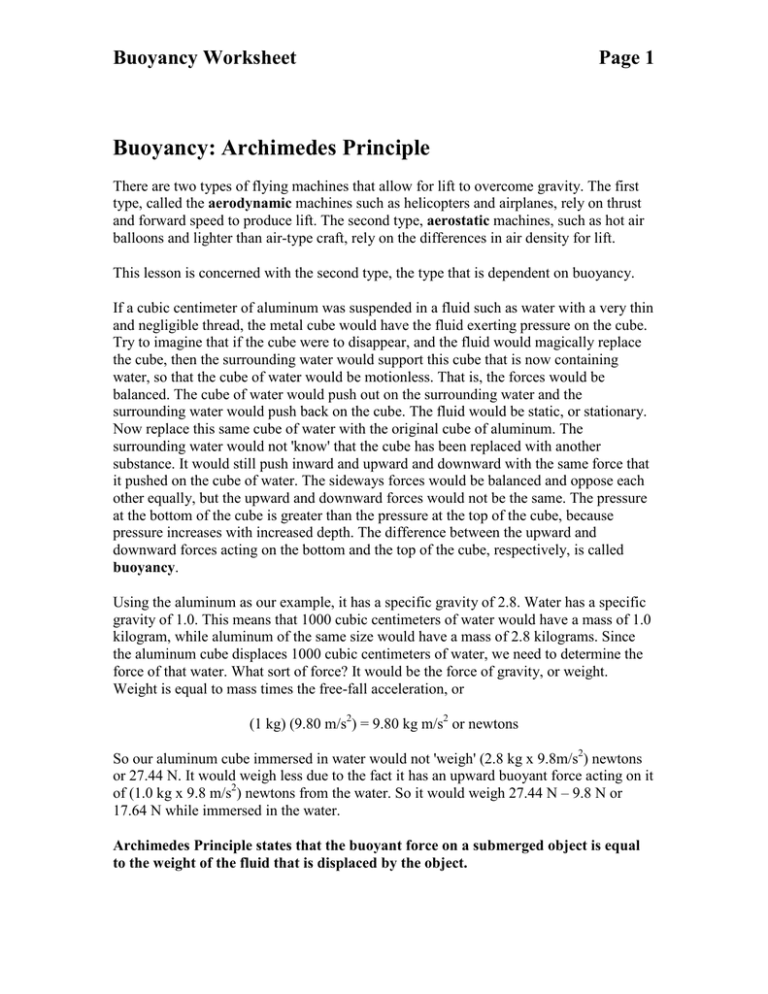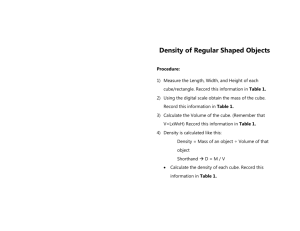Buoyancy & Archimedes' Principle Worksheet
advertisement

Buoyancy Worksheet Page 1 Buoyancy: Archimedes Principle There are two types of flying machines that allow for lift to overcome gravity. The first type, called the aerodynamic machines such as helicopters and airplanes, rely on thrust and forward speed to produce lift. The second type, aerostatic machines, such as hot air balloons and lighter than air-type craft, rely on the differences in air density for lift. This lesson is concerned with the second type, the type that is dependent on buoyancy. If a cubic centimeter of aluminum was suspended in a fluid such as water with a very thin and negligible thread, the metal cube would have the fluid exerting pressure on the cube. Try to imagine that if the cube were to disappear, and the fluid would magically replace the cube, then the surrounding water would support this cube that is now containing water, so that the cube of water would be motionless. That is, the forces would be balanced. The cube of water would push out on the surrounding water and the surrounding water would push back on the cube. The fluid would be static, or stationary. Now replace this same cube of water with the original cube of aluminum. The surrounding water would not 'know' that the cube has been replaced with another substance. It would still push inward and upward and downward with the same force that it pushed on the cube of water. The sideways forces would be balanced and oppose each other equally, but the upward and downward forces would not be the same. The pressure at the bottom of the cube is greater than the pressure at the top of the cube, because pressure increases with increased depth. The difference between the upward and downward forces acting on the bottom and the top of the cube, respectively, is called buoyancy. Using the aluminum as our example, it has a specific gravity of 2.8. Water has a specific gravity of 1.0. This means that 1000 cubic centimeters of water would have a mass of 1.0 kilogram, while aluminum of the same size would have a mass of 2.8 kilograms. Since the aluminum cube displaces 1000 cubic centimeters of water, we need to determine the force of that water. What sort of force? It would be the force of gravity, or weight. Weight is equal to mass times the free-fall acceleration, or (1 kg) (9.80 m/s2) = 9.80 kg m/s2 or newtons So our aluminum cube immersed in water would not 'weigh' (2.8 kg x 9.8m/s2) newtons or 27.44 N. It would weigh less due to the fact it has an upward buoyant force acting on it of (1.0 kg x 9.8 m/s2) newtons from the water. So it would weigh 27.44 N – 9.8 N or 17.64 N while immersed in the water. Archimedes Principle states that the buoyant force on a submerged object is equal to the weight of the fluid that is displaced by the object. Buoyancy Worksheet Page 2 Hot air balloons rise into the air because the density of the air (warmer air) inside the balloon is less dense than the air outside the balloon (cooler air). The balloon and the basket displaces a fluid that is heavier than the balloon and the basket, so it has a buoyant force acting on the system. Balloons tend to fly better in the morning, when the surrounding air is cool. Exercises: 1. Find the weight of the air in a room with dimensions of 20 ft x 12 ft x 15 ft. The weight density of air at sea level is 0.08 pounds /ft3. 2. An iron anchor weighs 250 pounds in air and has a weight density of 480 lbs/ft3. If it is immersed in sea water that has a weight density of 64 lbs/ft3, how much force would be required to lift it while it is immersed? 3. An aluminum bar weighs 17 pounds in air. How much force is required to lift the bar while it is immersed in gasoline? The weight density of aluminum is 170 pounds /ft3 and that of gasoline is 42 pounds /ft3. 4. How much does a 20 ft x 10 ft x 8 ft swimming pool filled with water weigh? Assume the water has a weight density of 62 lbs/ft3. 5. A balloon weighing 80 kg has a capacity of 1200 m3. If it is filled with helium, how great a payload can it support? The density of helium is 0.18 kg/ m3 and the density of air is 1.30 kg/ m3.



